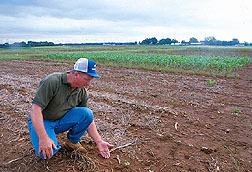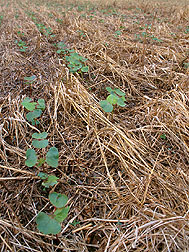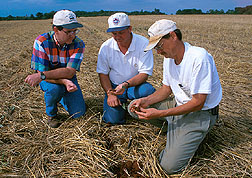Preserving Tennessee Valley Soils
For more than a century, generations of Tennessee Valley farmers have been growing cotton. It's been a staple cash crop in that region, which includes Tennessee and parts of Alabama, Mississippi, Kentucky, Georgia, North Carolina and Virginia.
The farmland in that once-fertile valley is showing its age. About 60 percent of the soil is highly erodible. Years of conventional tillage, coupled with little crop rotation, have severely depleted the soil organic matter—in some areas to less than 1 percent.
To save these valuable ancestral soils, resource specialists like conservation agronomist Ben Moore with USDA's Natural Resources Conservation Service (NRCS) in Troy, Alabama, have worked with valley farmers to help them comply with conservation management alternatives required by the Food Security Act of 1985. Growers who followed these conservation practices in earlier years ran into a stumbling block: reduced yields.
"That's mainly because crops previously grown under conservation tillage were not as competitive as those grown under conventional tillage," says Moore.
"Under provisions of the act, farmers can choose different options to reduce soil erosion," says Charles H. Burmester, a cotton specialist with the Alabama Cooperative Extension Service at Auburn University. "Farmers are beginning to see the benefits of crop rotations and working these rotations into a conservation tillage system," he says.
|
|
Helping to meet that challenge are researchers like D. Wayne Reeves and Randy L. Raper. Reeves, an agronomist, and Raper, an agricultural engineer, are with the Agricultural Research Service's National Soil Dynamics Laboratory (NSDL) in Auburn, Alabama. ARS, NRCS, and Auburn University started a joint Tennessee Valley project in 1994 to help cotton growers. The work has been supported in part by check-off funds from the Alabama Cotton Commission.
"Our goals are to develop tillage systems that will allow growers to maintain or improve cotton yields, reduce input costs, improve soil quality, and still be in line with conservation programs," says Reeves. He and Raper have developed a conservation tillage system that includes different tillage and planting practices, including using cover crops to add organic matter to build up the soil.
"Although the land is very fertile, the silty clay loam soils in this area are heavily eroded and heavily compacted—plant roots don't extend very deep," notes Reeves.
During the first 3 years of the study, Reeves found that noninversion deep tilling to 17 inches, which doesn't turn over the topsoil, and planting a rye cover crop in the fall increased cotton yields and reduced soil compaction. Three-year average yields for this system were about 1,040 pounds of lint per acre.
Says Reeves, "Our best conservation tillage treatment gave cotton yields that were 14 percent higher than those with conventional tillage and 18 percent higher than no tillage without using a cover crop—the system Tennessee Valley farmers adopted when they first went to conservation tillage."
|
|
Reeves says cold-tolerant rye planted every year as a winter cover crop is better than wheat, since rye makes more biomass for residue and controls weeds better. By the time cotton is harvested, it may mean planting the cover crop in late November or December, when it may reduce the potential for good wheat growth. He notes the study will continue so the system can be tested over a wide range of environmental conditions.
Grower Jimmy Blythe of Blythe Cotton Company in Courtland, Alabama, has been using a rye cover crop with no-till plantings for the last 3 years and conservation management for the past 7.
"I'm very pleased with the results," he says. "This year my cotton yields were about 50 pounds higher per acre than typical gin averages."
Blythe planted 2,100 acres of cotton, 1,200 acres of corn, and 600 acres of soybeans this year. He says conservation tillage can be successful, "but farmers can't give up after the first year of trying this system. It takes a commitment to do it year after year."
Dwain J. Reed, of Clark and Reed Consulting in Courtland, agrees that planting a cover crop, in addition to crop rotation, makes conservation tillage more feasible for farmers. Reed is a consultant to about 25 farmers in the Tennessee Valley region.
Some of the farmers are using conservation tillage, and some are using conventional systems," says Reed. "We've found that after a few years, the farmers using conservation tillage—if it's done correctly—have comparable yields and have virtually eliminated soil erosion."
"Some tillage may still be needed on certain soils," adds Alabama Extension's Burmester, "and we are trying to identify how often that may be."
NSDL's Raper is investigating the practicality of site-specific tillage practices. "Our data indicate a soil compaction problem exists in this region, which may require some form of tillage in combination with a cover crop," he says. "Extremely shallow tillage may not eliminate the problem, and excessively deep tillage wastes energy and may decrease cotton yields."
Raper adds that this may point to the need to measure depths of extreme soil compaction and then tilling to the appropriate depth. Using global positioning systems to locate these areas of deep compaction may allow site-specific tillage and precision agriculture to help, Raper says.
One tool is a new and improved multiple-probe, soil cone penetrometer that quickly determines a soil's strength across a field. Raper developed this tool, which he says will give researchers who are helping valley farmers a quick way to tell if plant roots will have a hard time pushing down into the soil.
Raper says farmers need this information so they can decide what depth of noninversion or other form of conservation tillage is best for their fields. In about a minute, the probe tests soil over an entire row for compaction or for layering that restricts root growth.
Reeves and Raper will continue to work closely with Tennessee Valley farmers and Burmester, who has been instrumental in helping the farmers implement ARS recommendations.—By Tara Weaver-Missick, Agricultural Research Service Information Staff.
This research is part of Soil Resource Management, an ARS National Program described on the World Wide Web at http://www.nps.ars.usda.gov/programs/nrsas.htm.
D. Wayne Reeves and Randy L. Raper are at the USDA-ARS National Soil Dynamics Laboratory, 411 S. Donahue St., Auburn, AL 36832; phone (334) 844-4666 [Reeves], (334) 844-4654 [Raper], fax (334)887-8597.
"Preserving Tennessee Valley Soils" was published in the August 1999 issue of Agricultural Research magazine.










